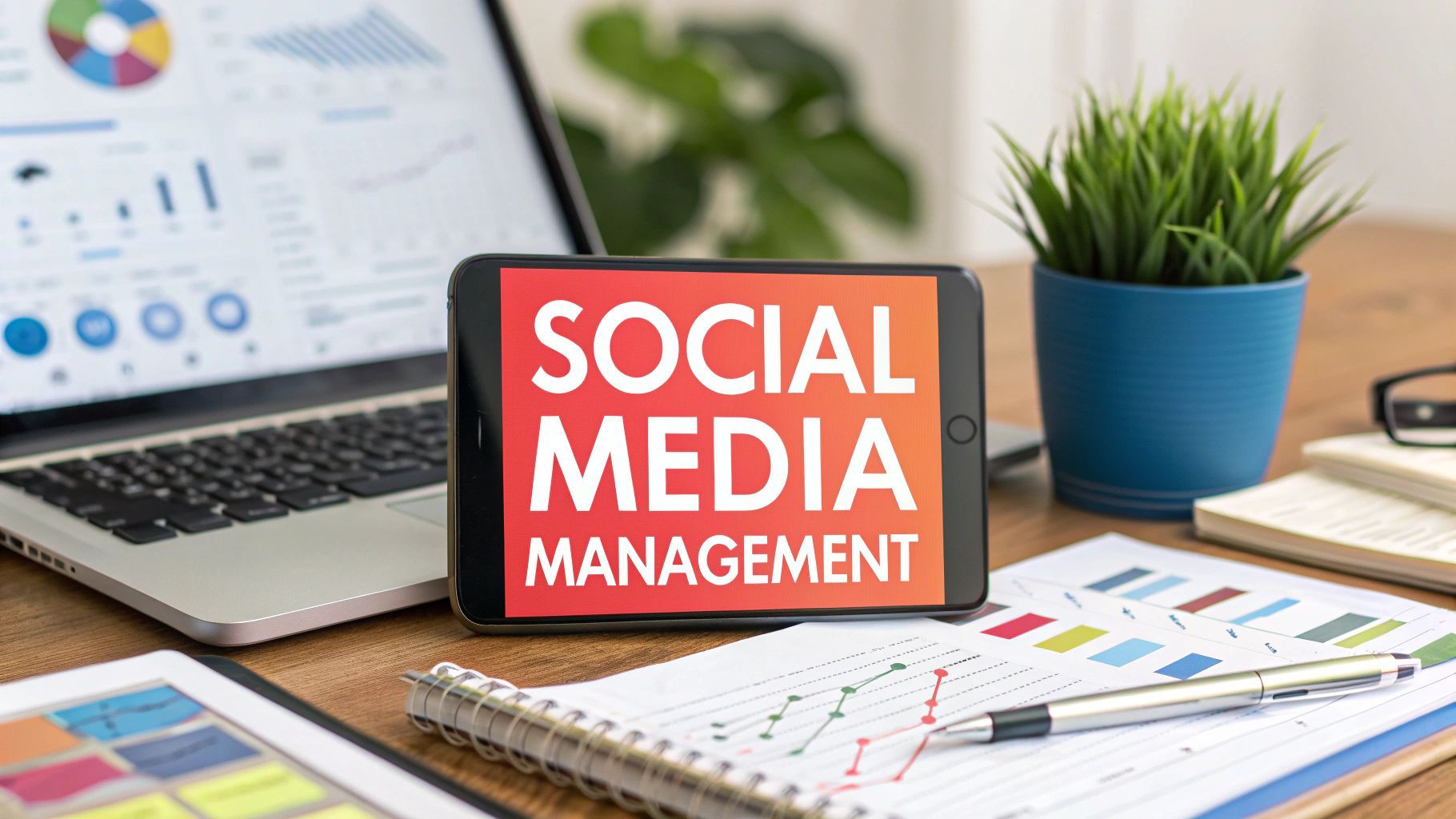How to Calculate Customer Acquisition Cost in the UK
At its core, calculating your customer acquisition cost is pretty straightforward. You just divide your total sales and marketing costs by the number of new customers you've brought in over a specific period. It’s a simple formula, but the insight it gives you is incredibly powerful – a clear snapshot of exactly what it costs to win over each new client.
Why Mastering Your Customer Acquisition Cost Matters

Understanding your Customer Acquisition Cost (CAC) is no longer just a nice to have metric for your monthly report. For UK businesses today, it’s a vital tool for survival and growth. With ad costs spiralling and customers thinking twice before they spend, knowing precisely how much it costs to win someone over is fundamental to building a business that actually makes money.
The idea is simple, but its ripple effects are huge. Every pound you spend – from marketing campaigns and sales team salaries to your software subscriptions – feeds into this one number. If you don't have a firm grip on your CAC, you’re basically flying blind. You can't make smart decisions about where to put your money for the best return.
The Current UK Business Climate
For businesses here in the UK, getting CAC right has become urgent. In 2025 , the cost to acquire a customer has hit an all-time high, thanks to a perfect storm of economic and market pressures.
The UK economy is only expected to grow by a modest 0.3% in 2025 , and consumer spending is creeping up by just 1.3% , which means overall demand is sluggish at best. On top of that, ad costs on major platforms like Meta and Google are soaring due to fierce competition. It’s no surprise that many UK brands are seeing their returns shrink, forcing them to find more sustainable ways to grow.
This tough environment makes a deep understanding of your CAC non-negotiable. It’s the first step to making your spending more efficient and ensuring your business is built to last. A big part of mastering CAC is knowing how to measure marketing effectiveness across every single one of your campaigns.
The Building Blocks of Profitability
Knowing your CAC isn't just about cutting costs; it’s about building a business model that works. It helps you answer the big questions that directly hit your bottom line:
- Is our marketing budget actually working? Tracking CAC shows you which channels are giving you the most bang for your buck.
- Are we pricing our products right? Your CAC sets a baseline that helps you figure out if your prices can support profitable growth.
- How long until we’re in the black? This metric is crucial for forecasting and winning over investors because it maps out a clear path to profitability.
By treating CAC not just as a historical number but as a forward looking guide, you can turn a simple calculation into a powerful lever for growth. It moves from being a reactive measure to a proactive strategic tool.
Think of this guide as your practical playbook. We’re going to break down exactly how to calculate your customer acquisition cost, pull the right data, and – most importantly – use that knowledge to make smarter decisions that will drive your business forward.
Gathering Your Data for an Accurate CAC Calculation
The old saying 'rubbish in, rubbish out' could have been invented for calculating Customer Acquisition Cost. Your final CAC figure is only as good as the data you feed into it. To get a number you can actually trust to make business decisions, you need to be almost obsessive about what you track.
Let's get past the basic formula and into the nitty gritty of what data you really need to pull together. This means taking a hard look at both sides of the equation: every cost involved and the precise number of new customers you've actually won.
Itemising Your Total Sales and Marketing Costs
First up, you need to tally every single penny spent on winning customers within a set period. This is about so much more than just your ad spend. Forgetting a key expense is easily the most common mistake people make, and it gives you a CAC that looks artificially low and dangerously misleading.
To make sure you catch everything, it helps to break your costs down into clear categories. Here’s a checklist to get you started:
- Direct Advertising Spend: The obvious one. Pull together your total spend from all the platforms you use—Google Ads, Meta (for Facebook and Instagram), LinkedIn Ads, TikTok, and any other channels you're active on.
- Team Salaries and Wages: This means the gross salaries of everyone in your marketing and sales departments. If some team members wear multiple hats, you’ll need to work out what percentage of their salary is dedicated to acquisition focused work.
- Software and Tool Subscriptions: Make a list of all the software your teams rely on to bring in new business. This includes your CRM, email marketing platform, SEO tools like Ahrefs or Semrush , social media schedulers, and any analytics software.
- Creative and Content Production: Did you pay a freelance writer for blog posts? A graphic designer for new ad creative? Or a videographer for a promotional video? Every one of these external production costs needs to be in the mix.
- Agency and Contractor Fees: If you're working with a digital marketing agency, an SEO consultant, or a PPC specialist, their monthly retainers or project fees are a huge part of your acquisition costs.
Getting this right is absolutely critical. An incomplete cost summary doesn't just give you a wrong number; it gives you a false sense of security about your marketing's profitability. That can lead to some disastrous budget decisions down the line.
Defining and Counting Your New Customers
The other piece of the puzzle is deciding what a ‘new customer’ actually means to your business. It sounds simple, but this is where a lot of businesses get muddled. The key is consistency. You have to count the same type of customer, the same way, every time.
For a SaaS business, for instance, does a free trial sign up count as a new customer? It shouldn't. You should only count them once they become a paying subscriber . Mixing free users with paying customers will make your CAC look much better than it really is.
It's the same for an ecommerce business. A new customer is someone who has made their first ever purchase . A loyal customer making their fifth purchase doesn't get counted here, because you already paid to acquire them in a previous period.
Choosing Your Time Frame
Finally, you need to pick the timeframe you'll use for your calculation. The most common choices are either monthly or quarterly.
- Monthly: This is a great fit for businesses with shorter sales cycles, like most ecommerce brands or B2C companies. It lets you spot trends and react to performance changes fast.
- Quarterly: This tends to work better for B2B companies or any business with a longer, more considered buying process. A quarterly view smooths out the monthly bumps and gives you a more stable picture of your acquisition efforts.
Whichever you land on, consistency is paramount . Calculating CAC monthly one time and then quarterly the next makes it impossible to compare your performance and spot real trends. Pick a timeframe that makes sense for your business model and stick to it.
Understanding how to gather this data properly is a cornerstone of mastering marketing performance metrics and building sustainable growth.
A Practical Walkthrough of CAC Calculations
Okay, you've got the theory down and you know where to find the data. Now for the fun part: putting it all into practice. The best way to really get your head around calculating customer acquisition cost is to walk through a couple of real world scenarios. Let's break down the numbers for two very different UK based businesses to see how this all works.
This infographic gives you a clean visual of the data flow. Think of it as your roadmap for any CAC calculation, showing how your costs, customer numbers, and the time period all fit together.

As you can see, it all starts with getting a firm grip on your total costs, pinning down the exact number of new customers, and deciding on the specific timeframe you’re analysing.
Example One: A London Apparel Brand
Let's imagine a direct to consumer (D2C) fashion brand operating out of London. Their sales cycle is fast and furious, so they calculate their CAC monthly. It’s the only way they can keep a tight leash on campaign performance and react quickly.
For the month of March, their spending sheet looked something like this:
- Google & Meta Ad Spend: £15,000
- Marketing Team Salaries: £8,000 (for two people)
- Software Subscriptions (CRM, Email): £500
- Freelance Content Creator Fees: £1,000
That brings their Total Sales & Marketing Costs to a neat £24,500 for the month.
In that same period, they brought in 475 new customers – people who made their very first purchase.
Time to plug it into the formula:
CAC = £24,500 / 475 = £51.58
So, it costs this London brand £51.58 to win over each new customer. That one number is their north star. It tells them whether their average order value and customer loyalty are strong enough to make this spend worthwhile.
Example Two: A Manchester B2B SaaS Company
Now, let's switch gears and head to Manchester to look at a B2B SaaS company. Here, the sales process is a marathon, not a sprint, often taking several months to get a deal over the line. Because of this, they calculate CAC quarterly to smooth out the lumps and bumps for a more meaningful picture.
Here’s a breakdown of their costs for Q1:
- LinkedIn Ads & PPC Spend: £20,000
- Sales & Marketing Salaries: £35,000 (covering a team of four)
- Software Stack (CRM, Analytics, etc.): £2,500
- Trade Show & Event Costs: £5,000
Their Total Sales & Marketing Costs for the quarter add up to £62,500 .
Over those three months, the sales team signed contracts with 75 new companies .
Let’s run the formula again:
CAC = £62,500 / 75 = £833.33
The Manchester SaaS company’s CAC is £833.33 per client. That might look eye wateringly high next to the fashion brand, but it's all about context. The value of that customer is completely different. If their clients are locked into a monthly subscription for years to come, that acquisition cost could actually be incredibly profitable.
The key takeaway here is simple: a "good" CAC is completely relative to your business model. There's no magic number. What truly matters is the relationship between your CAC and the revenue each customer generates over their lifetime.
Going a Step Further with Blended vs. Paid CAC
Your basic CAC calculation gives you a "blended" figure. It’s a useful average, lumping all your costs and customers together whether they came from paid ads, organic search, or a referral. It’s a brilliant starting point, but the sharpest marketers don't stop there.
UK ecommerce brands, for example, are navigating a tough market. Some projections suggest CAC could jump by around 40% between 2023 and 2025 . This makes it absolutely critical to know which channels are bleeding money. With UK businesses in this space losing an average of £23 per new customer after all costs are factored in, efficiency is everything.
This is where calculating a Paid CAC comes in. By isolating only the costs and customers that came directly from paid advertising, you get a much clearer picture of your ad spend's performance. It’s a vital piece of the puzzle when you need to measure the ROI of your UK marketing efforts.
Taking this even further by calculating a channel specific CAC for SEO, content, or social media gives you the intel needed to double down on what works and pull back on what doesn’t. If you want to streamline the process, a good customer acquisition cost calculator can help you wrangle the numbers and make sure no crucial costs slip through the cracks.
Benchmarking Your CAC Against UK Industry Averages
So, you’ve done the number crunching and finally have your Customer Acquisition Cost. Great. But what happens next? A number on its own is just data. The real question is, "Is my CAC any good?"
To answer that, you need context. This is where benchmarking comes in, letting you see how your performance stacks up against others in your industry. A £50 CAC might be fantastic for a fast fashion brand, but it would spell disaster for a high end software company. Comparing your figure to UK industry averages helps you set realistic targets and spot any major red flags in your marketing or sales process.
Average Customer Acquisition Cost (CAC) by UK Industry
Here’s a snapshot of what you can typically expect to see across different UK sectors. This isn't about finding a perfect match but about getting a feel for the ballpark you’re playing in.
| Industry Sector | Average CAC (Approx. GBP) | Key Influencing Factors |
|---|---|---|
| SaaS (Software) | £435 (blended) | Long sales cycles, high competition, value of recurring revenue, complexity of the product. |
| E-commerce (General) | £43 - £74 | High volume, low margins, fierce ad competition, reliance on paid channels like social media. |
| E-commerce (Fashion) | £54 | Trend driven market, high return rates, influencer marketing costs. |
| E-commerce (Jewellery) | £74 | Higher price points, longer consideration periods, need for high trust marketing. |
| Amazon UK Sellers | £15 - £58 | Platform fees, PPC ad spend (Sponsored Products), category saturation. |
As you can see, the numbers vary wildly. This is why having a clear understanding of your own sector's benchmarks is so crucial for proper budgeting and performance management. These figures, which you can explore in more detail here , highlight just how different the cost of winning a customer can be.
The Metric That Really Matters: LTV to CAC Ratio
While industry benchmarks are a useful yardstick, the true health check for your business isn't just your CAC. It’s how that number relates to your Customer Lifetime Value (LTV) —the total revenue a single customer will bring you over their entire relationship with your business.
The LTV:CAC ratio cuts through the noise. It tells you exactly how much you're getting back for every pound you spend on acquisition. Is your growth actually profitable and sustainable? This ratio has the answer.
A healthy business model is built on acquiring customers for less than they are worth. The LTV:CAC ratio cuts through the noise and shows you precisely how well you are achieving this fundamental goal.
A ratio of 1:1 is a warning sign. You’re essentially spending a pound to make a pound, which means you’re losing money once you factor in all your other business costs. It’s not a sustainable place to be.
For most businesses, the sweet spot is a ratio of at least 3:1 . This means for every £1 you spend to acquire a customer, you generate £3 in lifetime value. It shows you have a solid, scalable business model with enough margin to cover costs and reinvest in growth.
Interestingly, if your ratio is much higher—say, 5:1 or more—it might actually be a sign that you’re underinvesting in marketing and could be growing much faster.
Actionable Strategies to Reduce Your Customer Acquisition Cost

Knowing your Customer Acquisition Cost is the first step. The real magic, though, happens when you use that number to make smarter decisions. A high CAC isn't a failure; it’s a bright, flashing arrow pointing you toward opportunities to make your business leaner and more profitable.
The goal isn't just to slash costs but to do it without compromising on the quality or volume of new customers. This is about shifting your mindset from "let's just pump more money into ads" to a more strategic, sustainable approach.
By fine tuning what you're already doing and investing in long term assets, you can make every pound in your marketing budget work much harder. Let's dig into a few practical ways you can start doing this right now.
Double Down on Conversion Rate Optimisation
Honestly, one of the fastest routes to a lower CAC is simply getting more from the website traffic you already have. This is what Conversion Rate Optimisation (CRO) is all about. If you can nudge up the percentage of visitors who buy something or fill out a form, you’re acquiring more customers from the exact same marketing spend.
Put it this way: a campaign costs you £1,000 and brings in 1,000 visitors. If 10 of them convert, your CAC is £100 . But if you optimise your site and get 20 conversions from that same group, your CAC is suddenly slashed to £50 . You’ve halved your cost without spending a single extra penny on advertising.
You can start with small but powerful tweaks:
- A/B Test Your Calls to Action (CTAs): Play around with the wording, colours, and placement of your buttons. You'd be surprised what a difference a small change can make.
- Simplify Your Checkout: Every extra field or step is another reason for someone to abandon their cart. Research shows a clunky checkout process is why 21% of shoppers give up on a purchase.
- Boost Your Page Load Speed: A one second delay can kill your conversion rates. Use a speed analysis tool to find and fix whatever is slowing you down.
CRO is such a powerful lever because it makes your entire marketing funnel more efficient. You’re not just buying more traffic; you’re increasing the value of the traffic you’ve already got.
To get this right, you need to understand the fundamentals. We’ve put together a full guide to help you learn what conversion rate optimisation is and how to boost your website’s performance.
Harness the Power of Customer Referrals
Your happiest customers can become your most powerful (and cheapest) sales team. A smart referral programme gives your satisfied clients a reason to become genuine advocates, bringing in high quality leads that cost a fraction of what you'd spend on traditional ads.
The trust factor here is massive. A recommendation from a friend will always carry more weight than a paid advertisement. Data consistently shows that referred customers are more loyal and have a higher lifetime value. It’s a win-win.
To get a referral programme firing on all cylinders:
- Keep it Simple: Make the process of referring a friend and getting the reward completely effortless.
- Offer a Two Sided Deal: Reward the existing customer for spreading the word and the new customer for signing up. Everyone feels like they've got a good deal.
- Shout About It: Don't just bury your referral scheme on a forgotten page. Promote it in your emails, on social media, and especially right after a customer has had a great experience with you.
Focus on Retention to Fuel Growth
It might sound a bit backwards, but one of the best ways to lower your long term acquisition cost is to get better at keeping the customers you already have. After all, getting a new customer can cost up to five times more than retaining an existing one.
When you keep more customers, their lifetime value (LTV) naturally goes up. This improves your crucial LTV:CAC ratio and gives you more financial wiggle room to acquire new customers. Better yet, happy, loyal customers are the ones who start referring others, creating a virtuous cycle of low cost growth.
Invest in Long Term Organic Channels
Paid ads get you results fast, but it's a tap you have to keep running. The moment you turn off the spend, the leads stop. Organic channels like Search Engine Optimisation (SEO) and content marketing are different. They are assets that you build over time.
While they do have an upfront cost – writing the content, hiring an SEO pro – they eventually deliver a steady stream of interested customers for a tiny marginal cost. That blog post you publish today could be attracting and converting people for years, driving the CAC for that specific piece of content incredibly close to zero.
Common Questions About CAC
Even once you've got the hang of calculating your customer acquisition cost, a few common questions always seem to surface. Nailing down these details is key to making sure you're using the metric properly and getting real value from it.
Let's break down a few of the most frequent queries we hear from business owners and marketers.
What's the Difference Between CAC and CPA?
It's incredibly easy to get these two mixed up, but they measure very different things.
Think of Cost Per Acquisition (CPA) as a micro, campaign level metric. It tells you the cost of a specific action – like a lead signing up for a newsletter, someone downloading a whitepaper, or a user clicking on an advert.
Customer Acquisition Cost (CAC) , on the other hand, is a much broader, business level metric. It’s the total cost to bring a new paying customer into the business, rolling up all your sales and marketing spend. It’s not just about one click or one download.
In short, CPA measures a single step in the journey; CAC measures the final, paying destination.
CPA is a fantastic tool for tweaking and optimising individual marketing campaigns. But CAC is the metric that tells you if your overall business model is actually profitable and built to last.
How Often Should I Be Calculating My CAC?
The right rhythm for calculating your CAC really comes down to your sales cycle. Whatever you decide, the most important thing is to be consistent.
-
Monthly: This is the sweet spot for most businesses. If you're in ecommerce or B2C where the journey from first click to purchase is short, a monthly check-in is perfect. It lets you spot trends and react to changes in performance without missing a beat.
-
Quarterly: For B2B companies or any business with a longer sales cycle (we're talking several months), a quarterly calculation gives you a much more stable and meaningful picture. It smooths out the monthly bumps and gives you a clearer view of your long term acquisition health.
Can My CAC Ever Be Zero?
In a word: no. The idea of a zero CAC is a myth, even when you’re relying on so called 'free' marketing channels.
While you might not be paying directly for adverts, there are always indirect costs that have to be factored in.
Take organic search (SEO), for instance. Sure, you aren't paying Google for the clicks. But what about the salary of your content writer, or the monthly fee for your SEO software? These are very real expenses tied directly to winning customers through that channel.
Even a customer who finds you through word of mouth has a cost attached. It might be the cost of running a referral programme, or simply the initial cost you paid to acquire the original happy customer who started spreading the word. Getting honest about these hidden costs is vital for a true assessment of your business's financial health.
At Superhub , we help businesses across the UK demystify their marketing metrics and build profitable growth strategies. If you're ready to get a clear picture of your performance and drive real results, learn more at https://www.superhub.biz.





